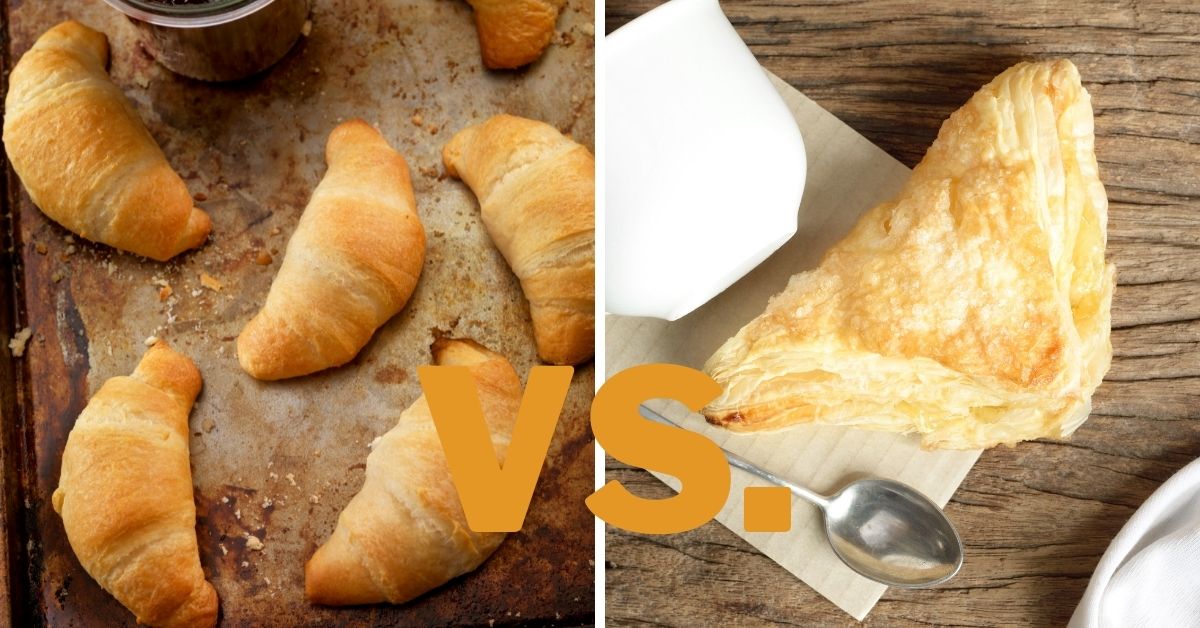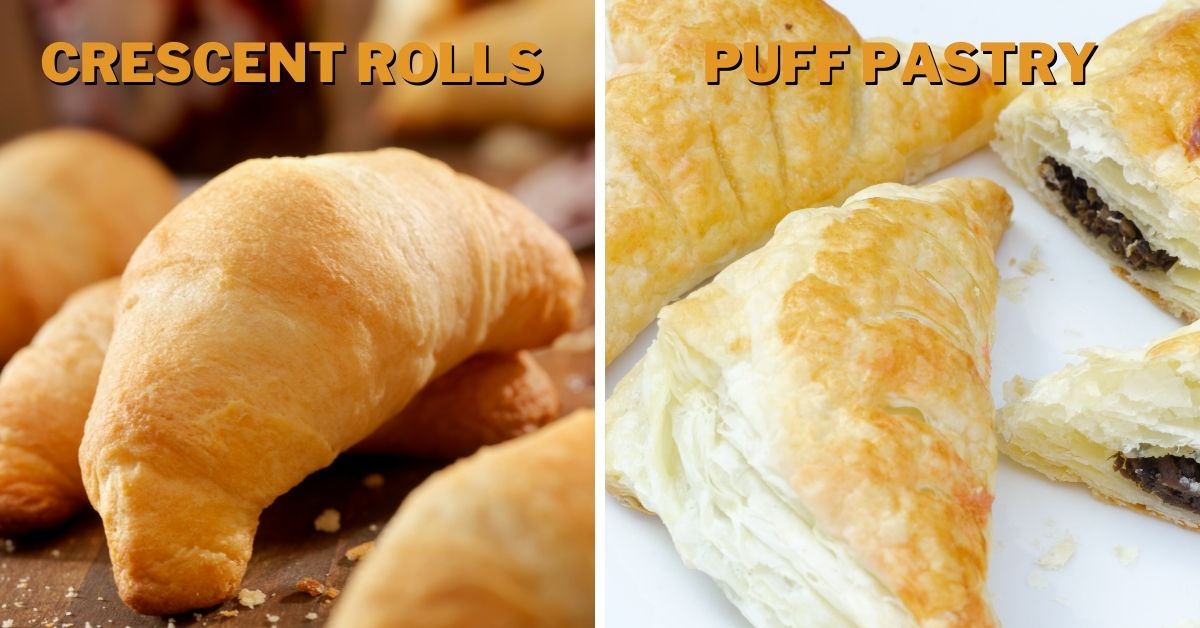Crescent Rolls vs. Puff Pastry: Differences & Which Is Better?

They are airy and light and have justifiably acquired the name of being among the most elegant pastries. Moreover, both crescent rolls and puff pastry handle filling excellently, but they are delicious plain and with no filling. As similar as they are, puff pastry and crescent rolls are different. So, what are the differences between crescent rolls and puff pastry?
The yeast is the most significant determining factor making these two types of pastries different. Puff pastry is made of laminated dough with no yeast, while crescent rolls are made of laminated dough with yeast.
To the untrained eye, it doesn’t make that big of a difference whether there’s yeast or not, but it often is the decisive factor dividing two types of dough or two types of pastry into two separate categories. Although the taste differences are very subtle, it is a rude offense to classify puff pastry and crescent rolls as being the same, as they both require skill and knowledge. Therefore, in the following paragraphs, I will explain the difference between puff pastry and crescent rolls in terms of making, quality, nutrition, and other specificities that make them unique.
Crescent Rolls and Puff Pastry: Differences
Both laminated, layered, buttery, and absolutely delicious puff pastry and crescent rolls are incredibly flaky and mouth-watering pastries. Although their differences are subtle, they are still significant enough to categorize these two as individual pastry types.
Preparation and Ingredients
The puff pastry ingredients are essential for obtaining dough- water, flour, and butter. There are other flavor-giving components, such as cocoa powder, vanilla extract, rum, etc., but they are optional and depend on what you want your puff pastry to taste like and are absolutely not compulsory elements of the puff pastry dough.
The technique used to make the puff pastry dough is called laminating. After the water and flour are mixed together, and you get the first dough, you laminate it by putting a larger piece of semi-softened unsalted butter in the middle and sealing the butter inside the dough. Then the dough and the butter are kneaded together, layering the butter and dough one over the other.
This process is called laminating, where you constantly fold the dough and butter. Different recipes call for different folding numbers, but the minimum number of folds is usually four. After each fold, the dough needs to be refrigerated, chilled to settle, and then folded again.
The process is fairly simple, but you need to be skilled and knowledgeable; otherwise, you’ll get a big lump of flour and butter.
The crescent roll dough is also laminated, but with one more detail, it is yeasted. While for puff pastry, you bond the ingredients using just water, for crescent rolls, you bond them by using activated yeast.
After mixing the flour and yeast, you need to add pea-sized pieces of cold butter to the mixture to start the laminating process. Puff pastry dough requires semi-melted butter for the layering, but for crescent rolls, the butter pieces need to be pea-sized because this dough is slightly more airy than the puff pastries.
Again, the dough is kneaded and folded until it is nicely layered. Then the crescent rolls are formed by cutting and rolling tringles into the crescent roll shapes.
Crescent rolls and puff pastry come out slightly crispy on the outside but incredibly soft and light on the inside. If skillfully done, you can see the layers of dough inside the puff pastry/crescent rolls.

Taste and Uses
The word that best describes what crescent rolls and puff pastry taste like is the word buttery. Both types of dough are insanely flakey and incredibly light. Often they are regarded as lighter than air, and rightfully so.
Crescent rolls and puff pastry can be sweet and savory, depending on what the rolls are filled with or whether the puff pastry contains sugar. Even though you don’t feel puff pastry, you can layer it with savory topping before you are done baking it.
If plain and done according to the traditional recipe, puff pastry and crescent rolls are very light, buttery, and refined.
Since puff pastry and crescent rolls come in sweet and savory varieties, they have many uses, both as dessert and dinner pastries. They can be a great companion to a cheese-based dish, a number of thick dips, cream soups, and potages.
They go great with meaty meals, as well as plain breakfast ideas. You can pair them with milk, cream cheese, and fresh fruits if you have them for breakfast or with something heavier and more complex if you have them as an addition to another meal.
In each case, the use of the crescent rolls and puff pastry mostly depends on whether they are sweet or savory, and both options have many uses.
Nutrition
Since the ingredients for puff pastry and crescent rolls are the same, with the crescent rolls containing yeast, which is lacking in the puff pastry dough, their nutritional values are nearly the same. [1] [2]
The serving sizes of crescent rolls and puff pastry are the same – 3 oz (28 grams), and they contain a moderate amount of carbs from the flour, fat from the butter, and in the case of crescent rolls, some of the yeast bacteria.
To say that puff pastry and crescent rolls are nutritious is not entirely true, as they don’t have much nutrition to offer, but they don’t contain any elements that could harm you either. If you compare them with bread, they would be better to have.
Popularity
Crescent rolls and puff pastry are famous worldwide. Depending on the culture, they have other characteristics specific to the cuisine in question. However, the key elements still stand.
They are a beloved product of many bakeries, and since they are easily made at home, many households have them regularly. Moreover, crescent rolls and puff pastry come factory-made and ready-to-buy in many local stores.
Crescent Rolls vs. Puff Pastry: Which Is Better?
Crescent rolls and puff pastry are impossible to divide according to quality. If a skillful baker has done them, then saying that one is better will be simply inaccurate. Puff pastry is usually not filled, but you can top it, and crescent rolls can contain the filling, or they can come plain.
Therefore, your decision should be based on what you would prefer at a given moment, as deciding which one is better is not a suitable criterion.
Can You Substitute Crescent Rolls for Puff Pastry?
Yes, you can substitute crescent rolls for puff pastry and vice versa. If you don’t have yeast, you can make puff pastry dough and shape the rolls with it. On the other hand, if you have ready crescent rolls dough, feel free to turn it into puff pastry.
